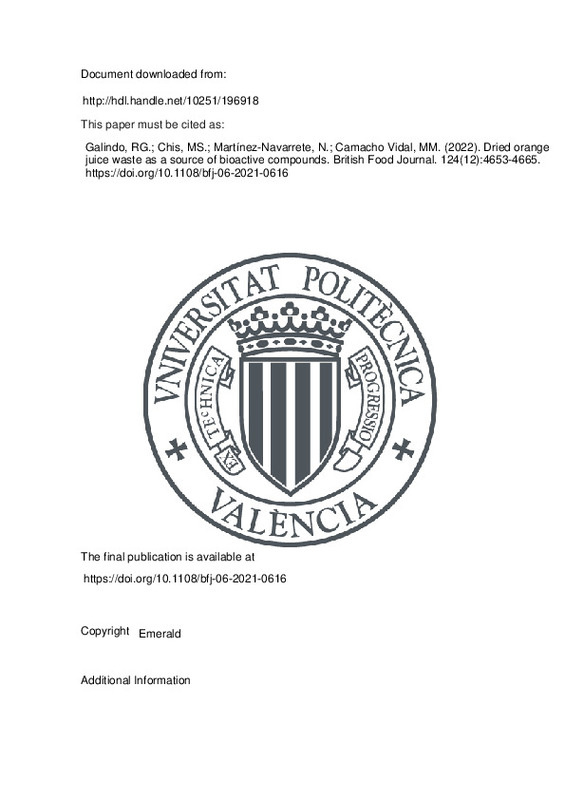JavaScript is disabled for your browser. Some features of this site may not work without it.
Buscar en RiuNet
Listar
Mi cuenta
Estadísticas
Ayuda RiuNet
Admin. UPV
Dried orange juice waste as a source of bioactive compounds
Mostrar el registro sencillo del ítem
Ficheros en el ítem
| dc.contributor.author | Galindo, Rosa Gabriela
|
es_ES |
| dc.contributor.author | Chis, Maria Simona
|
es_ES |
| dc.contributor.author | Martínez-Navarrete, Nuria
|
es_ES |
| dc.contributor.author | Camacho Vidal, Mª Mar
|
es_ES |
| dc.date.accessioned | 2023-09-21T18:05:44Z | |
| dc.date.available | 2023-09-21T18:05:44Z | |
| dc.date.issued | 2022-11-03 | es_ES |
| dc.identifier.issn | 0007-070X | es_ES |
| dc.identifier.uri | http://hdl.handle.net/10251/196918 | |
| dc.description.abstract | [EN] Purpose The waste generated in the process of obtaining orange juice (J) may be used as a natural source of bioactive compounds, thus contributing to the profitability and sustainability of the process. To offer orange J as a dried matter would contribute to the integral valorisation of the J waste and also may expand the field of application. Design/methodology/approach To find out whether the JW matrix protects the bioactive compounds, the study compares the behaviour of the extracts of the compounds against drying with that resulting from drying the JW for further extraction. Dehydration was carried out at 25 or 50 C and gum Arabic (GA) and bamboo fibre (BF) were used as stabilising biopolymers (Bp). Vitamin C (VC) (L-ascorbic and L-dehydroascorbic acids [AA and DHAA, respectively]) and hesperidin (HES) were analysed before and after the drying. Findings The results suggest that to dry the JW gives a higher yield of bioactive compounds, which are also more stable, than when the extract is dried. Furthermore, both the higher temperature and the presence of the Bp favour the extraction of both VC and HES. In this way, all the waste from the orange J-processing industries is converted into a high-value product to be used for cosmeceutical or nutraceutical purposes and also as an ingredient for human food. Social implications The utilisation of organic waste for use in human food, but also in other sectors, is part of the new economic model that aims to do away with the concept of waste as people know it, focussing on a new paradigm in which each resource is a nutrient for nature, industry or society. Originality/value The results suggest that to dry the waste gives a higher yield of bioactive compounds, which are also more stable, than when the extract is dried. Furthermore, both the higher temperature and the presence of the Bp favour the extraction of both VC and HES. In that way, all the waste from the orange J-processing industries are converted into a high-value product to be used for cosmeceutical or nutraceutical purposes and also as an ingredient for human food. | es_ES |
| dc.description.sponsorship | The authors thank the Ministerio de Economía, Industria y Competitividad and the Vicerrectorado de Investigación de la Universitat Politècnica de València for the financial support given through the Projects AGL 2017-89251-R (AEI/FEDER-UE) and (PAID-11-21), respectively. | es_ES |
| dc.language | Inglés | es_ES |
| dc.publisher | Emerald | es_ES |
| dc.relation.ispartof | British Food Journal | es_ES |
| dc.rights | Reconocimiento - No comercial (by-nc) | es_ES |
| dc.subject | Ascorbic acid | es_ES |
| dc.subject | Dehydroascorbic acid | es_ES |
| dc.subject | Hesperidin | es_ES |
| dc.subject | Orange juice waste | es_ES |
| dc.subject | Vitamin C extract | es_ES |
| dc.subject | Gum Arabic | es_ES |
| dc.subject | Bamboo fibre | es_ES |
| dc.subject | Drying temperature | es_ES |
| dc.subject.classification | TECNOLOGIA DE ALIMENTOS | es_ES |
| dc.title | Dried orange juice waste as a source of bioactive compounds | es_ES |
| dc.type | Artículo | es_ES |
| dc.identifier.doi | 10.1108/bfj-06-2021-0616 | es_ES |
| dc.relation.projectID | info:eu-repo/grantAgreement/AEI/Plan Estatal de Investigación Científica y Técnica y de Innovación 2013-2016/AGL2017-89251-R/ES/IMPACTO DE LAS CONDICIONES DE LIOFILIZACION EN LA CALIDAD DE PRODUCTOS DE FRUTA. INFLUENCIA DE LA MATRIZ/ | es_ES |
| dc.rights.accessRights | Abierto | es_ES |
| dc.contributor.affiliation | Universitat Politècnica de València. Escuela Técnica Superior de Ingeniería Agronómica y del Medio Natural - Escola Tècnica Superior d'Enginyeria Agronòmica i del Medi Natural | es_ES |
| dc.description.bibliographicCitation | Galindo, RG.; Chis, MS.; Martínez-Navarrete, N.; Camacho Vidal, MM. (2022). Dried orange juice waste as a source of bioactive compounds. British Food Journal. 124(12):4653-4665. https://doi.org/10.1108/bfj-06-2021-0616 | es_ES |
| dc.description.accrualMethod | S | es_ES |
| dc.relation.publisherversion | https://doi.org/10.1108/bfj-06-2021-0616 | es_ES |
| dc.description.upvformatpinicio | 4653 | es_ES |
| dc.description.upvformatpfin | 4665 | es_ES |
| dc.type.version | info:eu-repo/semantics/publishedVersion | es_ES |
| dc.description.volume | 124 | es_ES |
| dc.description.issue | 12 | es_ES |
| dc.relation.pasarela | S\455451 | es_ES |
| dc.contributor.funder | AGENCIA ESTATAL DE INVESTIGACION | es_ES |
| dc.subject.ods | 08.- Fomentar el crecimiento económico sostenido, inclusivo y sostenible, el empleo pleno y productivo, y el trabajo decente para todos | es_ES |







![[Cerrado]](/themes/UPV/images/candado.png)

